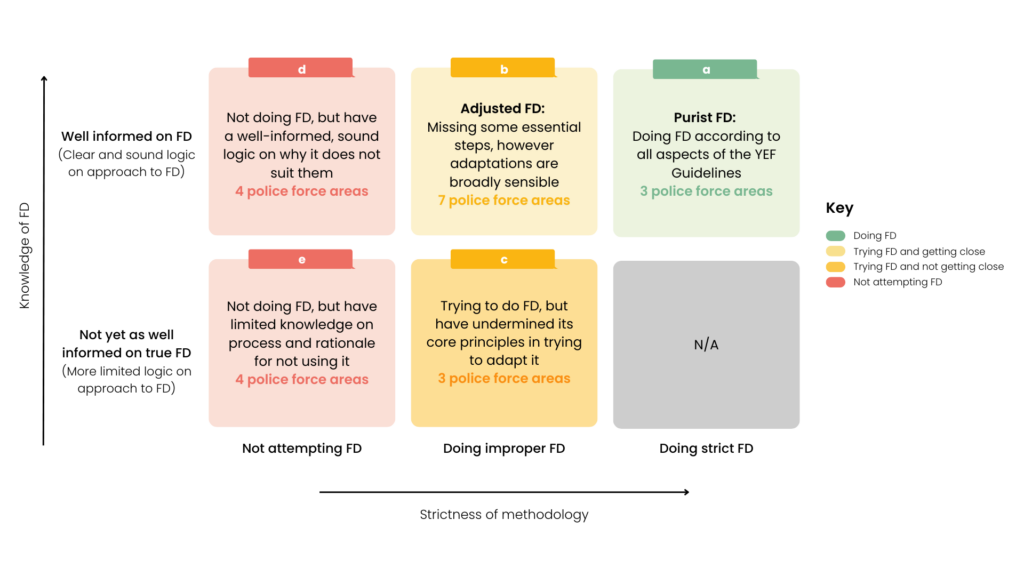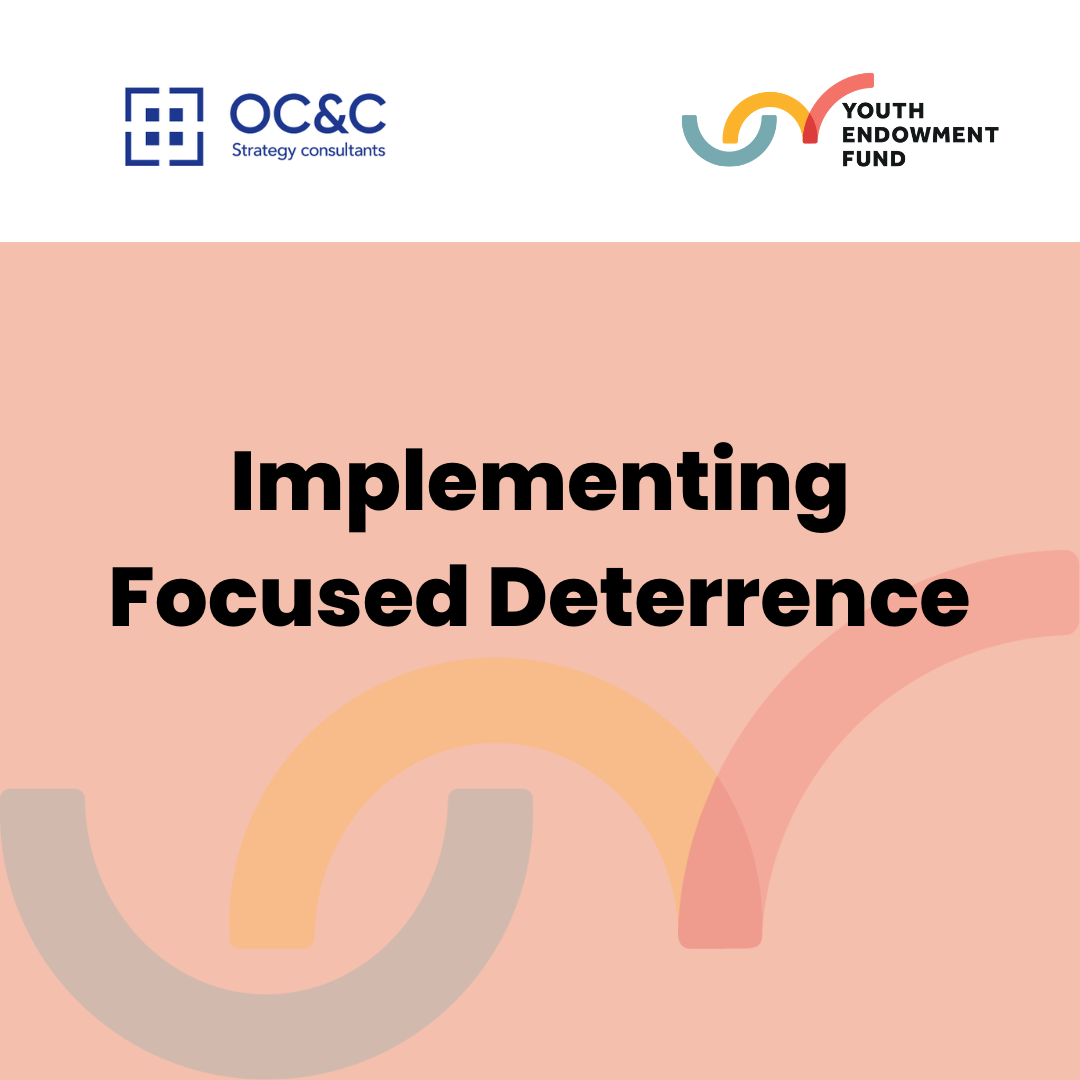Blog
It feels like everyone’s talking about focused deterrence. Since joining YEF eight months ago, it’s the intervention I’ve been asked most about; How can we deliver it in our local area? Is it really that effective? When will the findings from YEF’s multi-site trial be ready?
Alongside growing interest from government departments, we’ve seen an explosion in the delivery of local models of focused deterrence led by Violence Reduction Units and police forces. Given the interventions newfound popularity in the UK, it’s worth taking stock of what focused deterrence is, who and how it’s being delivered, and what YEF are doing to support implementation.
What is focused deterrence?
It combines several core strategies:
- Support - Helping people involved in violence to access positive support and social services. The goal is to address the underlying issues that contribute to violent behaviour, such as lack of education, employment, or housing.
- Community engagement - Engaging the wider community to communicate that they want violence to stop and those involved to be safe and provide support. Projects will sometimes arrange engagement between the people who are the focus of the intervention and victims’ family members, ex-group members, and trusted community leaders such as faith leaders. This approach helps in building trust and encouraging reintegration into the community.
- Deterrence – Communicating the consequences of violence, and swift and certain enforcement if violence occurs. Ensuring that individuals understand the repercussions of their actions.
At YEF, one of the key things we do is bring together all available evidence on a particular intervention or approach to understand how effective it is at reducing violence – this is known as a systematic review. Based upon the review of evidence (24 studies) for focused deterrence, we estimated that it can have a significant impact on violent crime, suggesting an average crime reduction of 33%. You’ll see on our Toolkit, which provides much more detail about this intervention, that focused deterrence shares the top spot with social skills training.
Challenges in implementing Focused Deterrence in the UK
Despite its potential, focused deterrence is not without challenges, particularly when trying to implement all of the key components. This is why we commissioned OC&C Strategy Consultants to find out:
- how it’s adopted across the UK and, when it is adopted, how closely it follows our guidelines on best practice;
- the main barriers to the adoption of best practice; and
- what we could do to help local areas overcome these barriers.
In total, OC&C Strategy Consultants spoke to 21 police forces and violence reduction units. Based upon these discussion, they developed five archetypes to categorise understanding and adherence to our focused deterrence framework which sets out a series of essential components.

Just three police force areas were categorised as doing ‘Purist Focused Deterrence’ (see the green box in the image above). These areas had a high-level of adherence to our framework, and had a robust understanding of the essential elements and how they were implementing them.
There were then ten police force areas who fell into the ‘Adjusted Focused Deterrence’ categories (as shown by the orange boxes in the image above). The difference between those force areas in category ‘b’ and ‘c’ is that while all were missing some of the essential components of focused deterrence, the force areas in category ‘b’ were able to provide a sound rationale for these adaptations.
Finally, OC&C Strategy Consultants identified eight police force areas that were not attempting focused deterrence (captured in the red boxes in the image above). Again, these force areas could be differentiated by those who understood what focused deterrence was and were able to explain why the approach wasn’t appropriate for their local area, and those who were unclear about what the intervention entailed.
Insights on alignment to our evidence-based framework are interesting but what’s most valuable is learning about the barriers faced by police force areas which lead to changes to the essential elements or not pursuing focused deterrence. Through this scoping exercise, OC&C Strategy Consultants asked force areas about the key barriers to delivering focused deterrence, and these were:
- Data and Intelligence: Collecting and using data and intelligence to inform the design and delivery of the intervention.
- Targeting specific problems: Identifying a specific violence problem and targeting the individuals associated with it.
- Multi-agency approach: De-prioritising the elements which are more challenging to implement such as the multi-agency approach and involving communities affected by violence.
- Clear consequences: The consequences of non-engagement or continued involvement in crime and violence (e.g. the deterrence element) aren’t always clearly articulated or routinely implemented.
Supporting local implementation
With a clearer understanding of the challenges, we started thinking about how we can support local areas in implementing focused deterrence. We’ve come up with a pipeline of outputs and activities intended to help policy-makers and practitioners to deliver this intervention effectively, including:
- Pilot Evaluation Report – We’re publishing the first evaluation report from our multi-site trial of focused deterrence, sharing emerging learning including what’s working well and less well.
- Implementation Tools – We’ll be working with experts to produce a resource of using data, intelligence and community insights, and another resource of recognising and embedding race equity within the context of focused deterrence.
- Practice Guidance – We’re collaborating with academics and practitioners to develop a comprehensive blueprint on how to implement focused deterrence effectively.
- Practice Workshops – We’ll bring together criminal justice agencies and other relevant stakeholders who are considering or doing focused deterrence to share our learning and provide support to local areas.
In short, if you’re interested in focused deterrence there are a lot of things to keep your eye out for which is why you might find it useful to sign up to our newsletter and visit our focused deterrence page where these outputs will be published.
Related content
- Research
Report:Implementing Focused Deterrence: Barriers and Opportunities
We asked OC&C Strategy Consultants to conduct a scoping exercise to help us understand which force areas are delivering focused deterrence and, importantly, how they’re delivering it. The insights collected as part of this project will be used to inform the development of practice guidance on focused deterrence. Research suggests that the average impact of…Policing -
Focused deterrence
A strategy that combines communicating the consequences of violence with support for developing positive routes away from it. - Blog
Blog:‘Focused deterrence’ holds promise for reducing serious violence
Prof. Iain Brennan and Dr Tia Simanovic discuss the ‘Another Chance’ project.


